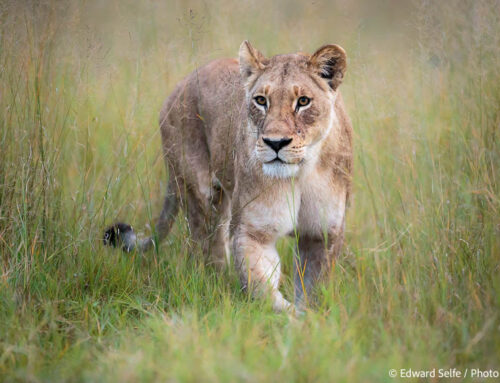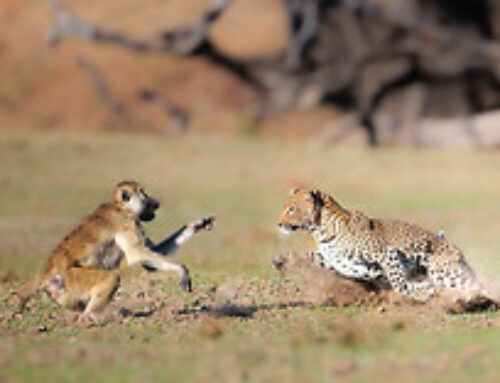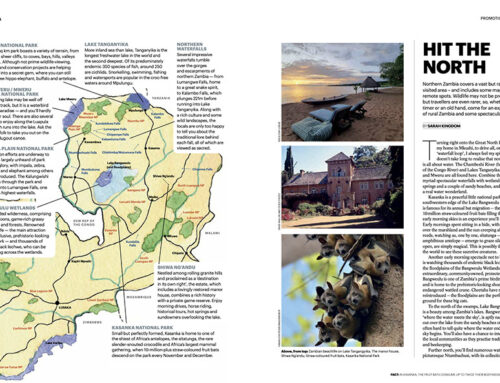- The Cool Dry – April to July
- The Hot Dry – August to October
- The Early Rains – November & December
- The Peak Rains – January to March
THE COOL DRY SEASON – APRIL TO JULY
Great Weather Conditions
As the final rains move away from Zambia, the weather turns cool and dry. While there is a small chance of rain in early April, it will mostly be cool mornings and warm crystal clear days. This season is ideal for those who enjoy a maximum temperature of 30C but bring warm clothes for the evenings, as the temperature drops dramatically at sunset.

Beautiful Scenery
Following the rains, the park is a green wonderland. But it dries up very quickly after the rains cease and the golden grass that results gives a beautiful backdrop for wildlife photography. The blue skies make for stunning reflections in the river and the sunlight begins to gain its characteristic soft African quality. The sunsets are outstanding.

Predators are very active
Cold mornings mean that predators are often active later into the day than in the hotter months. Luangwa’s famous leopards can be found prowling around in the early morning, and lions are found hunting late into the day. With the cooler conditions, it’s worth sitting with predators, knowing that they’ll probably hunt if an opportunity comes.
Varied Habitats
With pockets of inland water supporting life away from the river, our safaris take us throughout the National Park, in search of great sightings, wilderness and solitude. The variety of habitats in the Luangwa is quite extraordinary, and receives comments from every visitor.

Long safari days
These winter months give days with the longest photographic windows; the soft light extends late into the morning and the early afternoon light allows nice photographs from 3pm onwards. This is in stark contrast to the ‘summer’ months when bright light and harsh shadows leave photographers with fewer options after 9am.
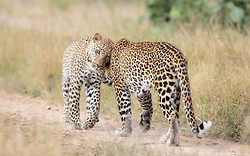
Great Weather Conditions
As the final rains move away from Zambia, the weather turns cool and dry. While there is a small chance of rain in early April, it will mostly be cool mornings and warm crystal clear days. This season is ideal for those who enjoy a maximum temperature of 30C but bring warm clothes for the evenings, as the temperature drops dramatically at sunset.
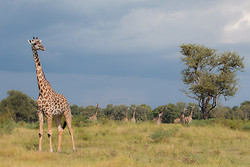
Beautiful Scenery
Following the rains, the park is a green wonderland. But it dries up very quickly after the rains cease and the golden grass that results gives a beautiful backdrop for wildlife photography. The blue skies make for stunning reflections in the river and the sunlight begins to gain its characteristic soft African quality. The sunsets are outstanding.
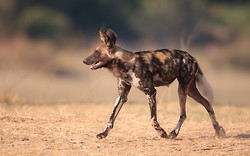
Predators are very active
Cold mornings mean that predators are often active later into the day than in the hotter months. Luangwa’s famous leopards can be found prowling around in the early morning, and lions are found hunting late into the day. With the cooler conditions, it’s worth sitting with predators, knowing that they’ll probably hunt if an opportunity comes.
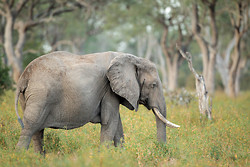
Varied Habitats
With pockets of inland water supporting life away from the river, our safaris take us throughout the National Park, in search of great sightings, wilderness and solitude. The variety of habitats in the Luangwa is quite extraordinary, and receives comments from every visitor.
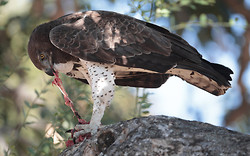
Outstanding Birdlife
Hundreds of species of birds to photograph and enjoy. Specialities, such as Pel’s Fishing Owl and large raptors, are commonly seen in the riverine forest areas in the central area of the park. Along the river myriad waterbirds, including Goliath heron and Saddle-billed storks, catch fish in the diminishing flow.
Hundreds of species of birds to photograph and enjoy. Specialities, such as Pel’s Fishing Owl and large raptors, are commonly seen in the riverine forest areas in the central area of the park. Along the river myriad waterbirds, including Goliath heron and Saddle-billed storks, catch fish in the diminishing flow.
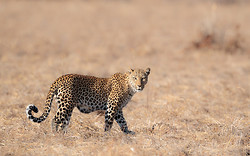
Long safari days
These winter months give days with the longest photographic windows; the soft light extends late into the morning and the early afternoon light allows nice photographs from 3pm onwards. This is in stark contrast to the ‘summer’ months when bright light and harsh shadows leave photographers with fewer options after 9am.
THE HOT DRY SEASON – AUGUST TO OCTOBER
Dramatic Weather Conditions
By this time, the last rains of the year are a distant memory and the dry season is heading towards its climax. Expect increasingly hot days (from mid-30s in August to mid-40s by late October) with very little humidity. Towards the end of the season, storm-clouds begin to build but there’s rarely rain before November. No warm clothes required!
Drama and Survival
Since there is so little water around, animals concentrate along the river. With so much game in such close proximity, sightings will always be fantastic at this time of year. It’s also a time of survival so not all the sightings will be easy to watch – at times nature can be cruel to observe.


Huge Concentrations of Game
Seeking protection, small buffalo herds throng together forming super-herds in numbers of over 500. Elephants congregate along the rivers, choosing to cross at sunset in search of greener pastures on the opposite bank.

Carmine Bee-eaters
For bird lovers, the ‘Carmines’ are a sight that should be on your bucket list. In fact, the vibrant colours, chirruping calls and sheer numbers of birds make a visit to a Carmine colony an awe-inspiring sight even for those who are not so keen on our feathered cousins. Of course, the photographic opportunities are outstanding.

Fast-drying Waterholes
The heat, which can be intense at times, dries waterholes at an astonishing rate. Hippos who hoped to live out the rest of the dry season in a small wallow are often frustrated as their muddy refuge disappears. Expect drama as these behemoths head to the river and try to carve out a living space for themselves.
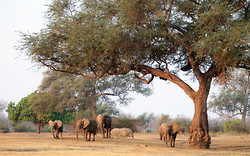
Dramatic Weather Conditions
By this time, the last rains of the year are a distant memory and the dry season is heading towards its climax. Expect increasingly hot days (from mid-30s in August to mid-40s by late October) with very little humidity. Towards the end of the season, storm-clouds begin to build but there’s rarely rain before November. No warm clothes required!
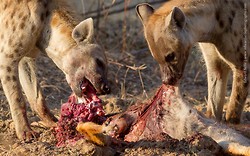
Drama and Survival
Since there is so little water around, animals concentrate along the river. With so much game in such close proximity, sightings will always be fantastic at this time of year. It’s also a time of survival so not all the sightings will be easy to watch – at times nature can be cruel to observe.
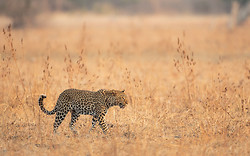
Beautiful and Interesting Light
The large quantities of dust blown into the atmosphere, combined with the bush- and grass-fires throughout Zambia, filter the bright sunlight and give stunning soft lighting in the morning and evening. It’s the time of year of classic ‘Golden African Light’.
The large quantities of dust blown into the atmosphere, combined with the bush- and grass-fires throughout Zambia, filter the bright sunlight and give stunning soft lighting in the morning and evening. It’s the time of year of classic ‘Golden African Light’.
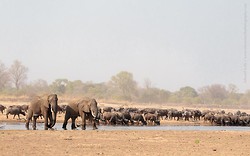
Huge Concentrations of Game
Seeking protection, small buffalo herds throng together forming super-herds in numbers of over 500. Elephants congregate along the rivers, choosing to cross at sunset in search of greener pastures on the opposite bank.
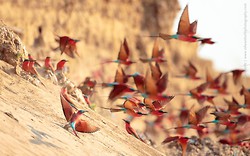
Carmine Bee-eaters
For bird lovers, the ‘Carmines’ are a sight that should be on your bucket list. In fact, the vibrant colours, chirruping calls and sheer numbers of birds make a visit to a Carmine colony an awe-inspiring sight even for those who are not so keen on our feathered cousins. Of course, the photographic opportunities are outstanding.
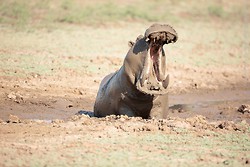
Fast-drying Waterholes
The heat, which can be intense at times, dries waterholes at an astonishing rate. Hippos who hoped to live out the rest of the dry season in a small wallow are often frustrated as their muddy refuge disappears. Expect drama as these behemoths head to the river and try to carve out a living space for themselves.
THE EARLY RAINS – NOVEMBER & DECEMBER





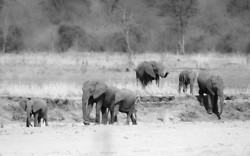
Unpredictable Weather Conditions
Predicting when the rains will arrive is a challenge that has eluded man since he first started agriculture. So I’ll just say that at some time in November or December, the rains will arrive, bringing green grass, muddy puddles and heavy deluges! Conditions at this time can be uncomfortably hot, as mid-40s temperatures combine with pre-rains humidity.
Predicting when the rains will arrive is a challenge that has eluded man since he first started agriculture. So I’ll just say that at some time in November or December, the rains will arrive, bringing green grass, muddy puddles and heavy deluges! Conditions at this time can be uncomfortably hot, as mid-40s temperatures combine with pre-rains humidity.
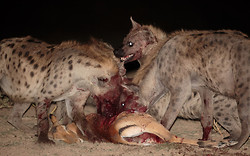
Death and Re-birth
This is a time of year of survival: if the rains come on time, those animals which have hung on to life through the long dry season might have a chance of another year. If not, they will likely fall victim to starvation, drought and opportunistic hunters such as hyaenas and stealthy leopards. When the rains do come, the transformation of the bush is rapid, impressive and absolute.
This is a time of year of survival: if the rains come on time, those animals which have hung on to life through the long dry season might have a chance of another year. If not, they will likely fall victim to starvation, drought and opportunistic hunters such as hyaenas and stealthy leopards. When the rains do come, the transformation of the bush is rapid, impressive and absolute.
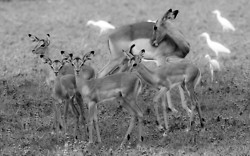
Baby Impalas!
Whether they should get a category of their own is up for discussion, but the annual impala calving brings smiles to faces after so many months of mere survival. Their long-legged wobbly antics are a joy to watch….and they stimulate plenty of predator activity too.
Whether they should get a category of their own is up for discussion, but the annual impala calving brings smiles to faces after so many months of mere survival. Their long-legged wobbly antics are a joy to watch….and they stimulate plenty of predator activity too.
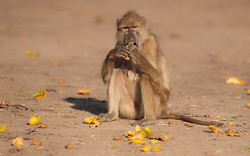
Mango Season
Coinciding with the arrival of the rains, the Wild Mango trees’ fruit ripens. This brings in elephants, monkeys, baboons, parrots, louries, barbets, pigeons and many more species to enjoy the rich crop. Expect squabbles and plenty of activity, especially as hungry elephants with new-born calves wade in to take their shares.
Coinciding with the arrival of the rains, the Wild Mango trees’ fruit ripens. This brings in elephants, monkeys, baboons, parrots, louries, barbets, pigeons and many more species to enjoy the rich crop. Expect squabbles and plenty of activity, especially as hungry elephants with new-born calves wade in to take their shares.
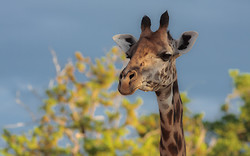
Thundery Skies
As thunderheads build up every afternoon, the opportunities for photography against the steel-blue skies should not be missed! There is nothing to compare with the golden light hitting your subject and dark grey skies providing a frame behind. Be ready to rush for cover occasionally!
As thunderheads build up every afternoon, the opportunities for photography against the steel-blue skies should not be missed! There is nothing to compare with the golden light hitting your subject and dark grey skies providing a frame behind. Be ready to rush for cover occasionally!
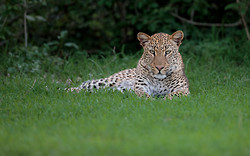
The Best of Both?
One of the benefits of the dry season is the absence of long grass that blocks clear photos. The early rains perhaps goes one better, offering a carpet of green grass like a well-maintained lawn. This gives the benefits both of visibility and a beautiful environment. This season is unpredictable, but the payouts can be astonishing.
One of the benefits of the dry season is the absence of long grass that blocks clear photos. The early rains perhaps goes one better, offering a carpet of green grass like a well-maintained lawn. This gives the benefits both of visibility and a beautiful environment. This season is unpredictable, but the payouts can be astonishing.
THE PEAK RAINS – JANUARY TO MARCH





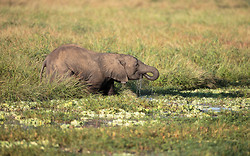
Challenging Weather Conditions
Once the rains settle in, with the ITCZ sitting above Zambia, there is likely to be rain most days. But in between, there are prolonged periods of sunshine and the weather can be beautiful. It’s mid-Summer so the sun rises early and sets late, giving long safari days with high humidity and maximum temperatures of mid-30s.
Once the rains settle in, with the ITCZ sitting above Zambia, there is likely to be rain most days. But in between, there are prolonged periods of sunshine and the weather can be beautiful. It’s mid-Summer so the sun rises early and sets late, giving long safari days with high humidity and maximum temperatures of mid-30s.
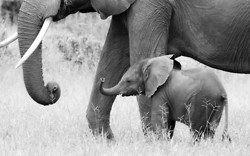
Abundance
After the initial flush of growth, the grass grows into a thick forest and the park is alive with the sounds of life. This is the bush at its most prolific. Vegetation feeds insects and mammals; insects feed birds and rodents; rodents and birds feed larger predators up the food chain – this is a time of life, growth and renewal, and all on African scale!
After the initial flush of growth, the grass grows into a thick forest and the park is alive with the sounds of life. This is the bush at its most prolific. Vegetation feeds insects and mammals; insects feed birds and rodents; rodents and birds feed larger predators up the food chain – this is a time of life, growth and renewal, and all on African scale!
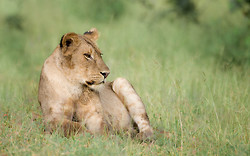
Many Predator Sightings
It’s a myth that prevails across Africa that there are fewer sightings to be had in the rains. Many predators such as hyaena and leopard are either territorial or heavily hefted to an area, so they are still found throughout the rains. In fact, with long, wet grass all over the place, they often use the most obvious transportation routes – the roads!
It’s a myth that prevails across Africa that there are fewer sightings to be had in the rains. Many predators such as hyaena and leopard are either territorial or heavily hefted to an area, so they are still found throughout the rains. In fact, with long, wet grass all over the place, they often use the most obvious transportation routes – the roads!
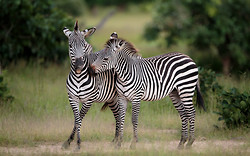
Very few people
So few people visit Africa’s National Parks during the rains that you are likely to be one of very few safari-goers entering the park each day. This gives you the unparalleled pleasure of being able to drive for hours and have the park to yourself. Want to sit for a while with a leopard? No problem, no one’s stopping you!
So few people visit Africa’s National Parks during the rains that you are likely to be one of very few safari-goers entering the park each day. This gives you the unparalleled pleasure of being able to drive for hours and have the park to yourself. Want to sit for a while with a leopard? No problem, no one’s stopping you!
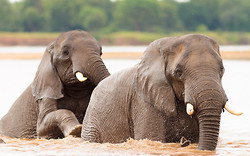
High Water
It is during these months that the river will reach its highest point for the year, and elephants don’t miss the chance to take the weight off their feet. Look out for black bulky blobs in the river, and more often than not, it’s elephant bulls playing together in the deep, muddy water!
It is during these months that the river will reach its highest point for the year, and elephants don’t miss the chance to take the weight off their feet. Look out for black bulky blobs in the river, and more often than not, it’s elephant bulls playing together in the deep, muddy water!
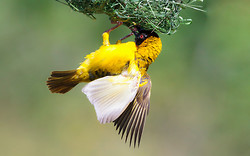
Breeding Birds
After all the posturing of the mating season in the early rains, the birds settle down to nest-building and chick-rearing. Watch as weavers thread fresh grasses together to form spherical nests, or busy Little Bee-eaters rush to and from their nest hole to deliver food to a chick.
After all the posturing of the mating season in the early rains, the birds settle down to nest-building and chick-rearing. Watch as weavers thread fresh grasses together to form spherical nests, or busy Little Bee-eaters rush to and from their nest hole to deliver food to a chick.

